Nursecate
On this page, you find all documents, package deals, and flashcards offered by seller NURSECATE.
- 537
- 0
- 0
Community
- Followers
- Following
537 items
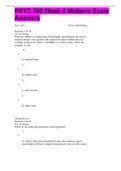
PSYC 300 Week 4 Midterm Exam Answers
Question 1 of 24 4.0/ 4.0 Points Professor Adams is constructing a demographic questionnaire for use in a research project. One question asks students to report whether they are currently living in an "urban", "suburban", or "rural" setting. This is an example of a/an: • A. nominal scale • B. ordinal scale • C. interval scale • D. ration scale Answer Key:A Question 2 of 24 4.0/ 4.0 Points Which of the following represents a null hypothesis? ...
- Exam (elaborations)
- • 18 pages •
Question 1 of 24 4.0/ 4.0 Points Professor Adams is constructing a demographic questionnaire for use in a research project. One question asks students to report whether they are currently living in an "urban", "suburban", or "rural" setting. This is an example of a/an: • A. nominal scale • B. ordinal scale • C. interval scale • D. ration scale Answer Key:A Question 2 of 24 4.0/ 4.0 Points Which of the following represents a null hypothesis? ...
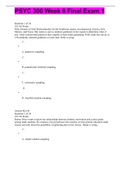
PSYC 300 Week 8 Final Exam 1
Question 1 of 24 4.0/ 4.0 Points Polly Petunia is Chief Horticulturalist for the Southwest region, encompassing Arizona, New Mexico, and Texas. She wants to survey amateur gardeners in her region to determine what, if any, water conservation practices they employ in their home gardening. Polly sends her survey to 150 randomly selected gardeners in each state. Polly is using: • A. purposive sampling. • B. proportional stratified sampling. • C. systematic sampling. • ...
- Exam (elaborations)
- • 15 pages •
Question 1 of 24 4.0/ 4.0 Points Polly Petunia is Chief Horticulturalist for the Southwest region, encompassing Arizona, New Mexico, and Texas. She wants to survey amateur gardeners in her region to determine what, if any, water conservation practices they employ in their home gardening. Polly sends her survey to 150 randomly selected gardeners in each state. Polly is using: • A. purposive sampling. • B. proportional stratified sampling. • C. systematic sampling. • ...
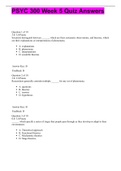
PSYC 300 Week 5 Quiz Answers
Question 1 of 10 3.0/ 3.0 Points Scientists distinguish between ______, which are their systematic observations, and theories, which are their explanations or interpretations of phenomena. • A. explanations • B. phenomena • C. interpretations • D. scientific theories Answer Key: B Feedback: B Question 2 of 10 3.0/ 3.0 Points Researchers generally consider multiple ______ for any set of phenomena. • A. questions • B. theories • C. reasons • D. hypot...
- Exam (elaborations)
- • 4 pages •
Question 1 of 10 3.0/ 3.0 Points Scientists distinguish between ______, which are their systematic observations, and theories, which are their explanations or interpretations of phenomena. • A. explanations • B. phenomena • C. interpretations • D. scientific theories Answer Key: B Feedback: B Question 2 of 10 3.0/ 3.0 Points Researchers generally consider multiple ______ for any set of phenomena. • A. questions • B. theories • C. reasons • D. hypot...
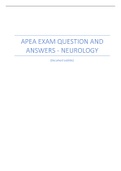
APEA Exam Question and Answers - Neurology
• The level of consciousness that refers to the ability of the patient to respond fully and appropriately to stimuli is known as: alertness • When assessing the patient’s sense of position, instruct the patient to first stand with his feet together and eyes open, then instruct him to close both eye for 30-60 seconds. If he loses his balance with his eyes closed, this is: suggestive of ataxia related to dorsal column disease • When comparing two sides of the body for symmetric sensation...
- Exam (elaborations)
- • 88 pages •
• The level of consciousness that refers to the ability of the patient to respond fully and appropriately to stimuli is known as: alertness • When assessing the patient’s sense of position, instruct the patient to first stand with his feet together and eyes open, then instruct him to close both eye for 30-60 seconds. If he loses his balance with his eyes closed, this is: suggestive of ataxia related to dorsal column disease • When comparing two sides of the body for symmetric sensation...
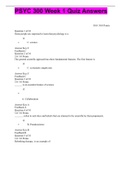
PSYC 300 Week 1 Quiz Answers
Question 1 of 10 Some people are surprised to learn that psychology is a • C. science. Answer Key:C Feedback:C Question 2 of 10 3.0/ 3.0 Points The general scientific approach has three fundamental features. The first feature is • C. systematic empiricism. Answer Key:C Feedback:C Question 3 of 10 3.0/ 3.0 Points ______ is an essential feature of science. • A. Collaboration Answer Key:A Feedback:A Question 4 of 10 3.0/ 3.0 Points _______...
- Exam (elaborations)
- • 3 pages •
Question 1 of 10 Some people are surprised to learn that psychology is a • C. science. Answer Key:C Feedback:C Question 2 of 10 3.0/ 3.0 Points The general scientific approach has three fundamental features. The first feature is • C. systematic empiricism. Answer Key:C Feedback:C Question 3 of 10 3.0/ 3.0 Points ______ is an essential feature of science. • A. Collaboration Answer Key:A Feedback:A Question 4 of 10 3.0/ 3.0 Points _______...
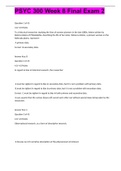
PSYC 300 Week 8 Final Exam 2
Question 1 of 45 3.0/ 3.0 Points To a historical researcher studying the lives of women pioneers in the late 1880s, letters written by Deloris Adams of Philadelphia, describing the life of her sister, Rebecca Adams, a pioneer woman on the Nebraska plains, represent: A.primary data. Correct B.secondary data. Answer Key: B Question 2 of 45 4.0/ 4.0 Points In regard to bias in historical research, the researcher: A.must be vigilant in regard to bias in secondary data, but it i...
- Exam (elaborations)
- • 17 pages •
Question 1 of 45 3.0/ 3.0 Points To a historical researcher studying the lives of women pioneers in the late 1880s, letters written by Deloris Adams of Philadelphia, describing the life of her sister, Rebecca Adams, a pioneer woman on the Nebraska plains, represent: A.primary data. Correct B.secondary data. Answer Key: B Question 2 of 45 4.0/ 4.0 Points In regard to bias in historical research, the researcher: A.must be vigilant in regard to bias in secondary data, but it i...
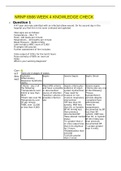
NRNP 6566 WEEK 4 KNOWLEDGE CHECK
A 47 year old male admitted with an infected elbow wound. On his second day in the hospital you find him in his room confused and agitated. Vital signs are as follows: Temperature – 96.2 °F Pulse -140 beats per minute Respirations – 40 breaths per minute Blood Pressure – 90/40 mmHg Labs include a WBC count of 3,000 Pt weighs 185 pounds Further assessment of him includes: • Urine output of 100cc for the last 8 hours • Pulse oximetry of 88% on room air • Pallor What is y...
- Exam (elaborations)
- • 7 pages •
A 47 year old male admitted with an infected elbow wound. On his second day in the hospital you find him in his room confused and agitated. Vital signs are as follows: Temperature – 96.2 °F Pulse -140 beats per minute Respirations – 40 breaths per minute Blood Pressure – 90/40 mmHg Labs include a WBC count of 3,000 Pt weighs 185 pounds Further assessment of him includes: • Urine output of 100cc for the last 8 hours • Pulse oximetry of 88% on room air • Pallor What is y...
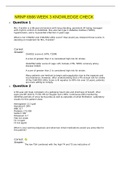
NRNP 6566 WEEK 3 KNOWLEDGE CHECK
Mrs. Franklin is a 68-year-old woman with long-standing, persistent AF being managed with rhythm control on dofetilide. She also has type 2 diabetes mellitus (T2DM), hypertension, and a myocardial infarction 3 years ago. What is her CHADS2 and CHA2DS2-VASc score? How would you interpret those scores in deciding on treatment for Mrs. Franklin? Correct Answer: CHADS2 score=2 (HTN, T2DM) A score of greater than 2 is considered high risk for stroke. CHA2DS2-VASc score=5 (age &g...
- Exam (elaborations)
- • 6 pages •
Mrs. Franklin is a 68-year-old woman with long-standing, persistent AF being managed with rhythm control on dofetilide. She also has type 2 diabetes mellitus (T2DM), hypertension, and a myocardial infarction 3 years ago. What is her CHADS2 and CHA2DS2-VASc score? How would you interpret those scores in deciding on treatment for Mrs. Franklin? Correct Answer: CHADS2 score=2 (HTN, T2DM) A score of greater than 2 is considered high risk for stroke. CHA2DS2-VASc score=5 (age &g...
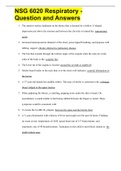
NSG 6020 Respiratory - Question and Answers
1. The anterior surface landmark on the thorax that is denoted by a hollow U-shaped depression just above the sternum and between the clavicles is termed the: suprasternal notch 2. Increased anteroposterior diameter of the chest, purse-lipped breathing, and dyspnea with talking, suggest: chronic obstructive pulmonary disease 3. The line that extends through the inferior angle of the scapula when the arms are at the sides of the body is the: scapular line 4. The lower tip of the scapula is loc...
- Exam (elaborations)
- • 6 pages •
1. The anterior surface landmark on the thorax that is denoted by a hollow U-shaped depression just above the sternum and between the clavicles is termed the: suprasternal notch 2. Increased anteroposterior diameter of the chest, purse-lipped breathing, and dyspnea with talking, suggest: chronic obstructive pulmonary disease 3. The line that extends through the inferior angle of the scapula when the arms are at the sides of the body is the: scapular line 4. The lower tip of the scapula is loc...
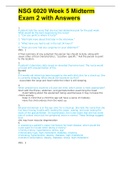
NSG 6020 Week 5 Midterm Exam 2 with Answers
A patient tells the nurse that she has had abdominal pain for the past week. What would be the best response by the nurse? 1. “Can you point to where it hurts?” 2. “We’ll talk more about that later in the interview.” 3. “What have you had to eat in the last 24 hours?” 4. “Have you ever had any surgeries on your abdomen?” ANS: 1 A final summary of any symptom the person has should include, along with seven other critical characteristics, “Location: specific.” Ask the ...
- Exam (elaborations)
- • 6 pages •
A patient tells the nurse that she has had abdominal pain for the past week. What would be the best response by the nurse? 1. “Can you point to where it hurts?” 2. “We’ll talk more about that later in the interview.” 3. “What have you had to eat in the last 24 hours?” 4. “Have you ever had any surgeries on your abdomen?” ANS: 1 A final summary of any symptom the person has should include, along with seven other critical characteristics, “Location: specific.” Ask the ...
